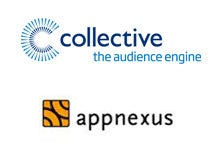 Real-time ad platform AppNexus and Collective, “a media and technology solutions provider for display advertising,” announced yesterday that Collective will integrate with AppNexus’ ad platform and leverage its tools and inventory, which includes the major ad exchanges like Google’s DoubleClick and Microsoft’s AdECN. Read the release.
Real-time ad platform AppNexus and Collective, “a media and technology solutions provider for display advertising,” announced yesterday that Collective will integrate with AppNexus’ ad platform and leverage its tools and inventory, which includes the major ad exchanges like Google’s DoubleClick and Microsoft’s AdECN. Read the release.
Collective EVP Jerome Fitzgibbons discussed the partnership and Collective buying strategy.
AdExchanger.com: Do you consider AppNexus infrastructure the basis for Collective’s demand-side platform? Will AMP run “over” or “through” AppNexus?
JF: Collective already is a demand side platform if you think about it. We serve agencies and advertisers seeking targeted online audiences at scale, and we manage that demand through our platform, AMP. Appnexus has done a great job providing access to ad exchanges, Collective brings best-of-breed data, brand protection, analytics and metrics that are most meaningful to brand advertisers. In this way, exchanges can be a great complement to our proprietary network of publishers.
Why is buying via real-time bidding important to Collective?
It’s not the real-time bidding that is important, so much as it it is access to audiences and ad impressions that work for advertisers at scale. Like most of the major ad networks, Collective has achieved around 70% reach of the US Internet audience. What our relationship with AppNexus adds is best-in-class access to ad exchanges, through which we can significantly increase the frequency of ad impressions to key audiences.
Generally speaking, are your brand advertisers ready for RTB-enabled buying? What are some of the ways you’re winning them over?
Brand protection and safe ad environments are critical to our clients, most of whom are large brand advertisers. Because AMP tests the ad environment before an ad is served, taking into account the publisher (is it on our white list), the ad environment (is it above the fold), the context of the page (using our Personifi semantic classification engine) and of course, the audience (analyze the attributes of the user, demos, psychographics, in-market behavior, etc.), we can offer a new level of brand safety to exchange buying. This combined with our proprietary ad effectiveness metrics, like engagement and time spent, and audience insights, including AudienceHD, give brand advertisers the efficiency and analytics they desire without compromising their brand in any way.
By John Ebbert










